A Comprehensive Review of Backfill Materials and Their Effects on Ground Heat Exchanger Performance
Abstract
1. Introduction
2. Conventional Backfill Materials
2.1. Pure Materials
2.2. Mixed Materials
3. Modern Backfill Materials
3.1. Introduction
3.2. Improved PCMs as Backfill Materials
3.2.1. Shape-Stabilized PCM (SSPCM)
3.2.2. Paraffin RT27, Acid and Enhanced Acid
4. Conclusions
- Bentonite has been used considerably as a backfill material in GHEs (about 17% of the time) over the past eight years, followed by silica sand and coarse/fine sand, both at 10%. Concrete backfill materials (7%) and a mixture of bentonite and water (7%) are also used.
- Improved PCMs, including microencapsulated PCM, SSPCM, acid, enhanced acid, and paraffin RT27, are used only in the cooling operation mode.
- Acid and SSPCM have been applied mostly among modern backfill materials in GHEs, with usage frequencies of 30% and 28%, respectively.
Author Contributions
Funding
Conflicts of Interest
Nomenclature
| Q | Heat exchange rate, W |
| ε | Effectiveness |
| COP | Coefficient of performance |
Abbreviations
| GSHP | Ground-source heat pump |
| GHE | Ground heat exchanger |
| PCM | Phase change material |
| PFA | Pulverized fuel ash |
| SSPCM | Shape-stabilized PCM |
| ENG | Expanded natural graphite |
| CENGg | Ground compressed ENG |
| CENGgx | CENGg with an apparent density x |
References
- Solak, A.M.; Tenza-Abril, A.J.; Saval, J.M.; García-Vera, V.E. Effects of multiple supplementary cementitious materials on workability and segregation resistance of lightweight aggregate concrete. Sustainability 2018, 10, 4304. [Google Scholar] [CrossRef]
- Letelier, V.; Ortega, J.; Tarela, E.; Muñoz, P.; Henríquez-Jara, B.; Moriconi, G. Mechanical performance of eco-friendly concretes with volcanic powder and recycled concrete aggregates. Sustainability 2018, 10, 3036. [Google Scholar] [CrossRef]
- Dincer, I.; Rosen, M.A. Thermodynamic aspects of renewables and sustainable development. Renew. Sustain. Energy Rev. 2005, 9, 169–189. [Google Scholar] [CrossRef]
- Alnahhal, M.F.; Alengaram, U.J.; Jumaat, M.Z.; Alqedra, M.A.; Mo, K.H.; Sumesh, M. Evaluation of industrial by-products as sustainable pozzolanic materials in recycled aggregate concrete. Sustainability 2017, 9, 767. [Google Scholar] [CrossRef]
- Coppola, L.; Coffetti, D.; Crotti, E. Plain and ultrafine fly ashes mortars for environmentally friendly construction materials. Sustainability 2018, 10, 874. [Google Scholar] [CrossRef]
- Al-Khoury, R. Computational Modeling of Shallow Geothermal Systems; CRC Press: Boca Raton, FL, USA, 2011. [Google Scholar]
- Rosen, M.A.; Koohi-Fayegh, S. Geothermal Energy: Sustainable Heating and Cooling Using the Ground; John Wiley & Sons: Hoboken, NJ, USA, 2017. [Google Scholar]
- Delaleux, F.; Py, X.; Olives, R.; Dominguez, A. Enhancement of geothermal borehole heat exchangers performances by improvement of bentonite grouts conductivity. Appl. Thermal Eng. 2012, 33–34, 92–99. [Google Scholar] [CrossRef]
- Lee, C.; Lee, K.; Choi, H.; Choi, H.-Y. Characteristics of thermally-enhanced bentonite grouts for geothermal heat exchanger in South Korea. Sci. China Ser. E Technol. Sci. 2010, 53, 123–128. [Google Scholar] [CrossRef]
- Allan, M.L. Materials characterization of superplasticized cement–sand grout. Cement Concr. Res. 2000, 30, 937–942. [Google Scholar] [CrossRef]
- Erol, S.; François, B. Efficiency of various grouting materials for borehole heat exchangers. Appl. Thermal Eng. 2014, 70, 788–799. [Google Scholar] [CrossRef]
- Kavanaugh, S.P.; Allan, M.L. Testing of thermally enhanced cement ground heat exchanger grouts. ASHRAE Trans. 1999, 105, 446–450. [Google Scholar]
- Zhang, W.; Yang, H.; Lu, L.; Fang, Z. Investigation on influential factors of engineering design of geothermal heat exchangers. Appl. Thermal Eng. 2015, 84, 310–319. [Google Scholar] [CrossRef]
- Borinaga-Treviño, R.; Pascual-Muñoz, P.; Castro-Fresno, D.; Blanco-Fernandez, E. Borehole thermal response and thermal resistance of four different grouting materials measured with a TRT. Appl. Thermal Eng. 2013, 53, 13–20. [Google Scholar] [CrossRef]
- Chen, S.; Mao, J. Quantitative evaluation of improper backfilling in vertical borehole. J. Thermal Sci. Technol. 2016, 11, JTST00018. [Google Scholar] [CrossRef]
- Kim, D.; Kim, G.; Kim, D.; Baek, H. Experimental and numerical investigation of thermal properties of cement-based grouts used for vertical ground heat exchanger. Renew. Energy 2017, 112, 260–267. [Google Scholar] [CrossRef]
- Jun, L.; Xu, Z.; Jun, G.; Jie, Y. Evaluation of heat exchange rate of GHE in geothermal heat pump systems. Renew. Energy 2009, 34, 2898–2904. [Google Scholar] [CrossRef]
- Allan, M.L.; Kavanaugh, S.P. Thermal conductivity of cementitious grouts and impact on heat exchanger length design for ground source heat pumps. HVAC&R Res. 1999, 5, 85–96. [Google Scholar]
- Remund, C.P. Borehole thermal resistance: Laboratory and field studies. ASHRAE Trans. 1999, 105, 439–445. [Google Scholar]
- Philippacopoulos, A.J.; Berndt, M.L. Influence of debonding in ground heat exchangers used with geothermal heat pumps. Geothermics 2001, 30, 527–545. [Google Scholar] [CrossRef]
- Allan, M.; Philippacopoulos, A.J. Performance characteristics and modelling of cementitious grouts for geothermal heat pumps. In Proceedings of the World Geothermal Congress, Kyushu, Japan, 28 May–10 June 2000; Volume 28, pp. 3355–3360. [Google Scholar]
- Smith, M.D.; Perry, R.L. Borehole grouting: Field studies and thermal performance testing. ASHRAE Trans. 1999, 105, 451–457. [Google Scholar]
- Reuss, M.; Proell, M.; Koenigsdorff, R. Quality control of borehole heat exchanger systems. In Proceedings of the EFFSTOCK 09, 11th International Conference on Thermal Energy Storage, Stockholm, Sweden, 14–17 June 2009; pp. 104–112. [Google Scholar]
- Herrmann, V.J. Engineering Geological Investigations on the Backfilling of Geothermal Boreholes with Geothermal Probes. PhD Dissertation, Karlsruhe Institute of Technology (KIT), Karlsruhe, Germany, 2008. [Google Scholar]
- Di Bitetti, M.S.; Ferreras, J.A. Publish (in English) or perish: The effect on citation rate of using languages other than English in scientific publications. Ambio 2017, 46, 121–127. [Google Scholar] [CrossRef] [PubMed]
- Guerrero-Bote, V.P. Félix Moya-Anegón. Downloads versus citations and the role of publication language. Res. Trends Issue 2014, 37, 19–22. [Google Scholar]
- Van Leeuwen, T.N.; Moed, H.F.; Tijssen, R.J.W.; Visser, M.S.; van Raan, A.F.J. Language biases in the coverage of the Science Citation Index and its consequencesfor international comparisons of national research performance. Scientometrics 2001, 51, 335–346. [Google Scholar] [CrossRef]
- Zhao, J.; Li, Y.; Wang, J. A review on heat transfer enhancement of borehole heat exchanger. Energy Procedia 2016, 104, 413–418. [Google Scholar] [CrossRef]
- Noorollahi, Y.; Saeidi, R.; Mohammadi, M.; Hosseinzadeh, M.; Amiri, A. The effects of ground heat exchanger parameters changes on geothermal heat pump performance-a review. Appl. Thermal Eng. 2017, 129, 1645–1658. [Google Scholar] [CrossRef]
- Pahud, D.; Matthey, B. Comparison of the thermal performance of double U-pipe borehole heat exchangers measured in situ. Energy Build. 2001, 33, 503–507. [Google Scholar] [CrossRef]
- Choi, W.; Ooka, R. Effect of natural convection on thermal response test conducted in saturated porous formation: Comparison of gravel-backfilled and cement-grouted borehole heat exchangers. Renew. Energy 2016, 96, 891–903. [Google Scholar] [CrossRef]
- Lee, C.; Park, S.; Lee, D.; Lee, I.; Choi, H. Viscosity and salinity effect on thermal performance of bentonite-based grouts for ground heat exchanger. Appl. Clay Sci. 2014, 101, 455–460. [Google Scholar] [CrossRef]
- Kara, Y.A. Experimental performance evaluation of a closed-loop vertical ground source heat pump in the heating mode using energy analysis method. Int. J. Energy Res. 2007, 31, 1504–1516. [Google Scholar] [CrossRef]
- Alberti, L.; Angelotti, A.; Antelmi, M.; la Licata, I. A numerical study on the impact of grouting material on borehole heat exchangers performance in aquifers. Energies 2017, 10, 703. [Google Scholar] [CrossRef]
- Zhuang, Y.C.; Hong, S.Y.; He, X.K. Study on performance of backfilled soil for vertical-buried closed-loop GSHP. Acta Energiae Sol. Sin. 2004, 25, 216–220. [Google Scholar]
- Carlson, S.W. GSHP bore field performance comparisons of standard and thermally enhanced grout. ASHRAE Trans. 2000, 106, 442–450. [Google Scholar]
- Allan, M.L.; Philippacopoulos, A.L. Thermal Conductivity of Cementitious Grouts for Geothermal Heat Pumps; Brookhaven National Laboratory for US Department of Energy: Upton, NY, USA, November 1998.
- Eckhart, F. Grouting Procedures for Ground-source Heat Pump Systems; Ground Source Heat Pump Publications; Oklahoma State University: Stillwater, OK, USA, 1991. [Google Scholar]
- Remund, C.P.; Lund, J.L. Thermal Enhancement of Bentonite Grouts for Vertical GSHP Systems. In Proceedings of the Heat Pump and Refrigeration Systems, Design, Analysis, and Applications, ASME Winter Annual Meeting, New Orleans, LA, USA, 28 November–3 December 1993; Volume 29, pp. 95–106. [Google Scholar]
- Erol, S.; François, B. Freeze damage of grouting materials for borehole heat exchanger: Experimental and analytical evaluations. Geomechan. Energy Environ. 2016, 5, 29–41. [Google Scholar] [CrossRef]
- Xu, Y.; Chung, D.D.L. Effect of sand addition on the specific heat and thermal conductivity of cement. Cement Concr. Res. 2000, 30, 59–61. [Google Scholar] [CrossRef]
- Jobmann, M.; Buntebarth, G. Influence of graphite and quartz addition on the thermo–physical properties of bentonite for sealing heat-generating radioactive waste. Appl. Clay Sci. 2009, 44, 206–210. [Google Scholar] [CrossRef]
- Desmedt, J.; van Bael, J.; Hoes, H.; Robeyn, N. Experimental performance of borehole heat exchangers and grouting materials for ground source heat pumps. Int. J. Energy Res. 2012, 36, 1238–1246. [Google Scholar] [CrossRef]
- Allan, M.L.; Philippacopoulos, A.J. Properties and Performance of Cement-Based Grouts for Geothermal Heat Pump Applications; Brookhaven National Laboratory for US Department of Energy: Upton, NY, USA, November 1999.
- Manso, J.M.; Gonzalez, J.J.; Polanco, J.A. Electric arc furnace slag in concrete. J. Mater. Civ. Eng. 2004, 16, 639–645. [Google Scholar] [CrossRef]
- Manso, J.M.; Polanco, J.A.; Losanez, M.; Gonzalez, J.J. Durability of concrete made with EAF slag as aggregate. Cement Concr. Compos. 2006, 28, 528–534. [Google Scholar] [CrossRef]
- Pellegrino, C.; Gaddo, V. Mechanical and durability characteristics of concrete containing EAF slag as aggregate. Cement Concr. Compos. 2009, 31, 663–671. [Google Scholar] [CrossRef]
- Borinaga-Trevino, R.; Pascual-Munoz, P.; Castro-Fresno, D.; del Coz-Díaz, J.J. Study of different grouting materials used in vertical geothermal closed-loop heat exchangers. Appl. Thermal Eng. 2013, 50, 159–167. [Google Scholar] [CrossRef]
- Yang, W.; Sun, L.; Wu, X. Energy storage and heat transfer characteristics of ground heat exchanger with phase change backfill materials. Trans. Chin. Soc. Agric. Eng. 2014, 30, 193–199. [Google Scholar]
- Kassai, M.; Poleczky, L.; Al-Hyari, L.; Kajtar, L.; Nyers, J. Investigation of the energy recovery potentials in ventilation systems in different climates. Facta Univ. Ser. Mech. Eng. 2018, 16, 203–217. [Google Scholar] [CrossRef]
- Rabin, Y.; Korin, E. Incorporation of phase-change materials into a ground thermal energy storage system: Theoretical study. J. Energy Resour. Technol. 1996, 118, 237–241. [Google Scholar] [CrossRef]
- Bottarelli, M.; Georgiev, A.; Aydin, A.A.; Su, Y.; Yousif, C. Ground-source heat pumps using phase change materials. In Proceedings of the European Geothermal Congress, Pisa, Italy, 3–7 June 2013; pp. 84–89. [Google Scholar]
- Kong, M.; Alvarado, J.L.; Thies, C.; Morefield, S.; Marsh, C.P. Field evaluation of microencapsulated phase change material slurry in ground source heat pump systems. Energy 2017, 122, 691–700. [Google Scholar] [CrossRef]
- Wang, J.L.; de Zhao, J.; Liu, N. Numerical simulation of borehole heat transfer with phase change material as grout. Appl. Mech. Mater. 2014, 577, 44–47. [Google Scholar] [CrossRef]
- Bottarelli, M.; Bortoloni, M.; Su, Y.; Yousif, C.; Aydın, A.A.; Georgiev, A. Numerical analysis of a novel ground heat exchanger coupled with phase change materials. Appl. Thermal Eng. 2015, 88, 369–375. [Google Scholar] [CrossRef]
- Bottarelli, M.; Bortoloni, M.; Su, Y. Heat transfer analysis of underground thermal energy storage in shallow trenches filled with encapsulated phase change materials. Appl. Thermal Eng. 2015, 90, 1044–1051. [Google Scholar] [CrossRef]
- Lei, H.; Zhu, N. Analysis of phase change materials (PCMs) used for borehole fill materials. Geotherm. Resour. Council Trans. 2009, 33, 93–98. [Google Scholar]
- Benli, H.; Durmuş, A. Evaluation of ground-source heat pump combined latent heat storage system performance in greenhouse heating. Energy Build. 2009, 41, 220–228. [Google Scholar] [CrossRef]
- Benli, H. Energetic performance analysis of a ground-source heat pump system with latent heat storage for a greenhouse heating. Energy Convers. Manag. 2011, 52, 581–589. [Google Scholar] [CrossRef]
- Real, A.; García, V.; Domenech, L.; Renau, J.; Montés, N.; Sánchez, F. Improvement of a heat pump based HVAC system with PCM thermal storage for cold accumulation and heat dissipation. Energy Build. 2014, 83, 108–116. [Google Scholar] [CrossRef]
- Moreno, P.; Castell, A.; Sole, C.; Zsembinszki, G.; Cabeza, L.F. PCM thermal energy storage tanks in heat pump system for space cooling. Energy Build. 2014, 82, 399–405. [Google Scholar] [CrossRef]
- Dehdezi, P.K.; Hall, M.R.; Dawson, A.R. Enhancement of soil thermo-physical properties using microencapsulated phase change materials for ground source heat pump applications. Appl. Mech. Mater. 2012, 110, 1191–1198. [Google Scholar] [CrossRef]
- Bottarelli, M.; Bortoloni, M.; Georgiev, A.; Aydin, A.A.; Su, Y.; Yousif, C. Ground-source heat pumps: Benefits of using phase change materials. In Proceedings of the Sustainable Energy Storage in Buildings Conference, Dublin, Ireland, 19–21 June 2013; pp. 29–33. [Google Scholar]
- Li, X.; Tong, C.; Duanmu, L.; Liu, L. Study of a U-tube heat exchanger using a shape-stabilized phase change backfill material. Sci. Technol. Built Environ. 2017, 23, 430–440. [Google Scholar] [CrossRef]
- Tian, Y.; Zhao, C.Y. A numerical investigation of heat transfer in phase change materials (PCMs) embedded in porous metals. Energy 2011, 36, 5539–5546. [Google Scholar] [CrossRef]
- Li, X.; Tong, C.; Duanmu, L.; Liu, L. Research on U-tube heat exchanger with shape-stabilized phase change backfill material. Procedia Eng. 2016, 146, 640–647. [Google Scholar] [CrossRef]
- Chen, F.; Mao, J.; Chen, S.; Li, C.; Hou, P.; Liao, L. Efficiency analysis of utilizing phase change materials as grout for a vertical U-tube heat exchanger coupled ground source heat pump system. Appl. Thermal Eng. 2018, 130, 698–709. [Google Scholar] [CrossRef]
- Assis, E.; Katsman, L.; Ziskind, G.; Letan, R. Numerical and experimental study of melting in a spherical shell. Int. J. Heat Mass Transfer 2007, 50, 1790–1804. [Google Scholar] [CrossRef]
- Yan, L.H. Analytical and Experimental Study of Phase Change Materials Used as Backfill Material for Borehole Heat Exchangers. PhD Dissertation, Tianjin University, Tianjin, China, 2011. [Google Scholar]
- Qi, D.; Pu, L.; Sun, F.; Li, Y. Numerical investigation on thermal performance of ground heat exchangers using phase change materials as grout for ground source heat pump system. Appl. Thermal Eng. 2016, 106, 1023–1032. [Google Scholar] [CrossRef]
- Lei, H.; Dai, C. Comparative experiment of different backfill grouts for concentric ground heat exchangers. Geotherm. Resour. Council Trans. 2013, 37, 597–600. [Google Scholar]
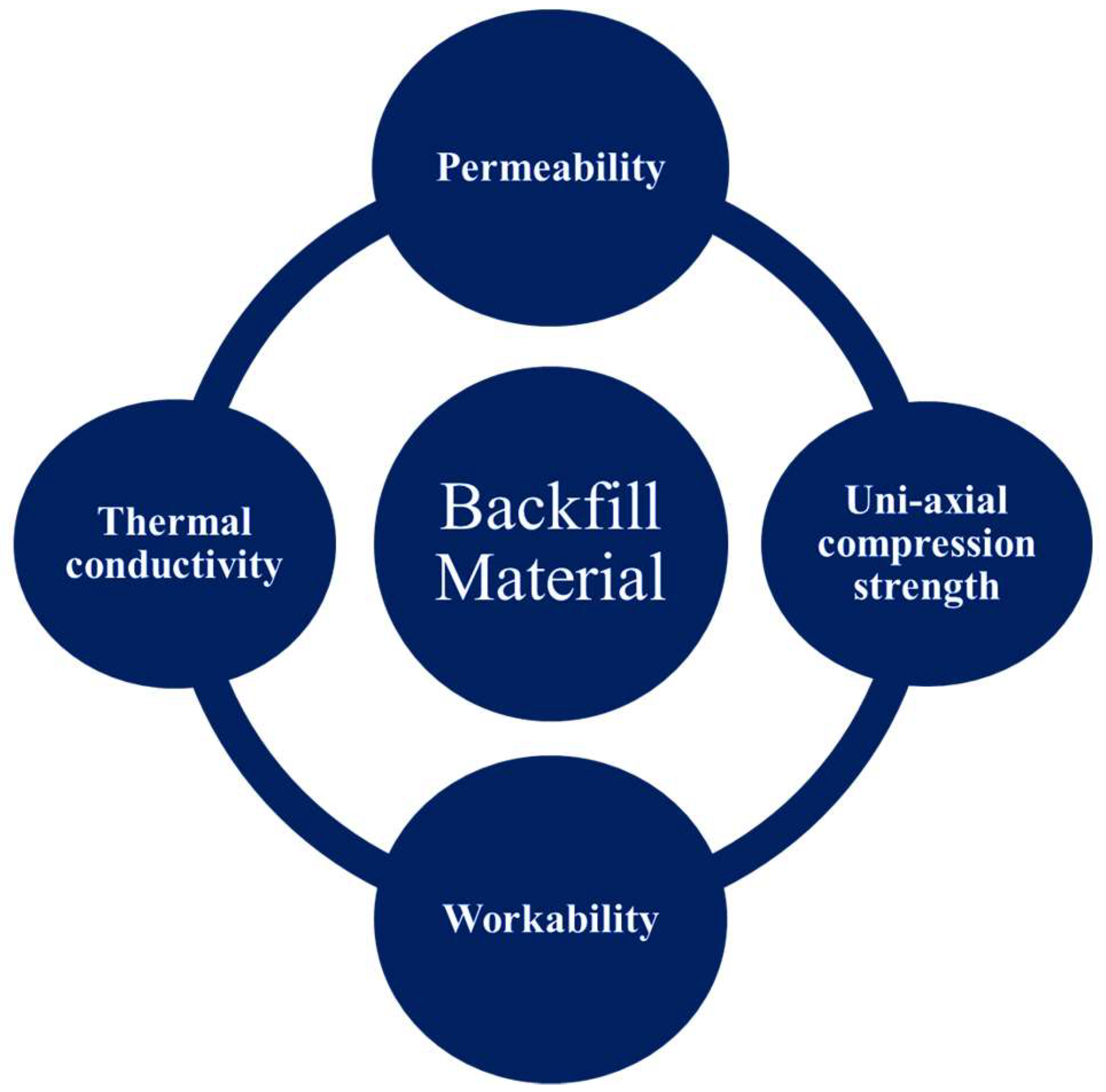
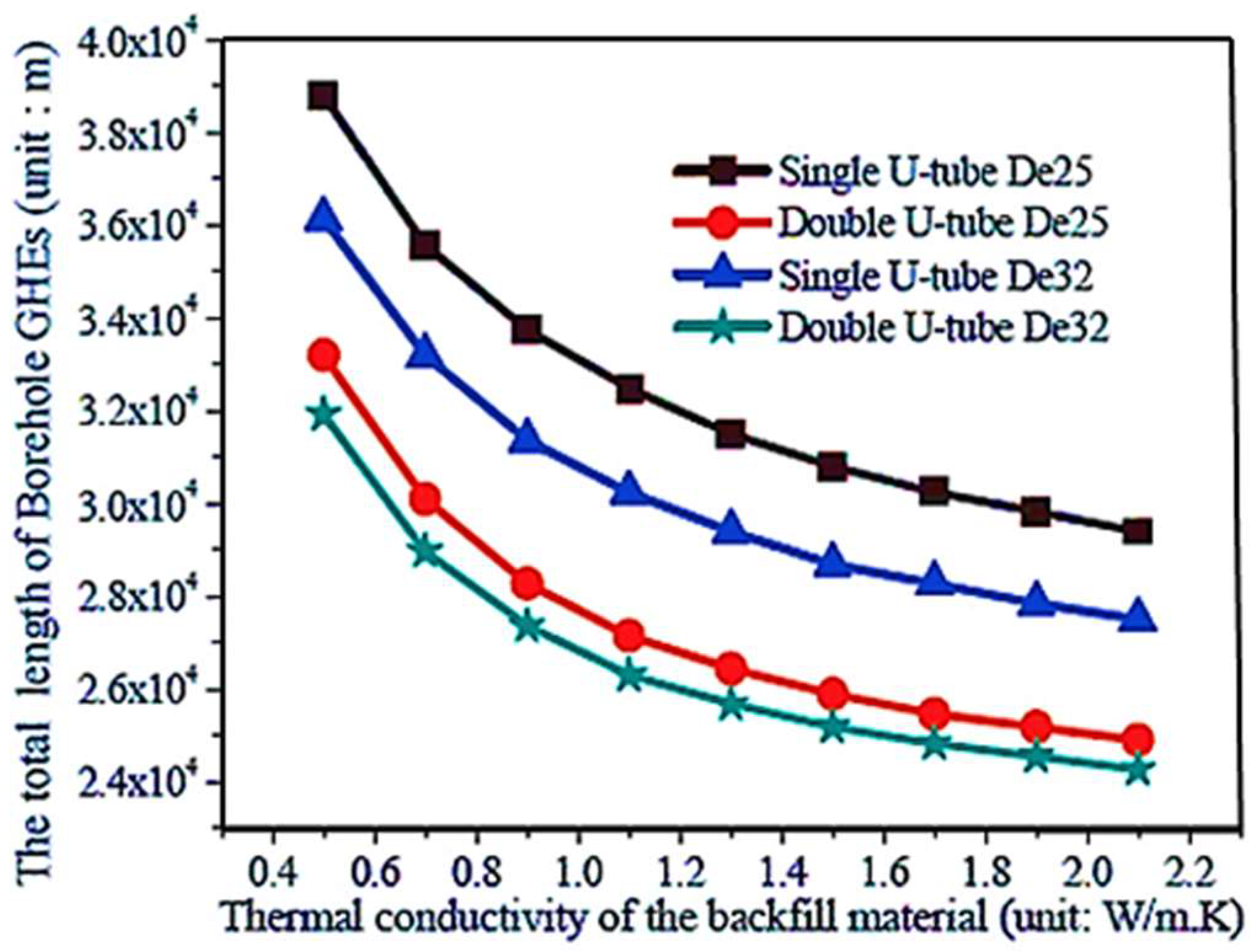


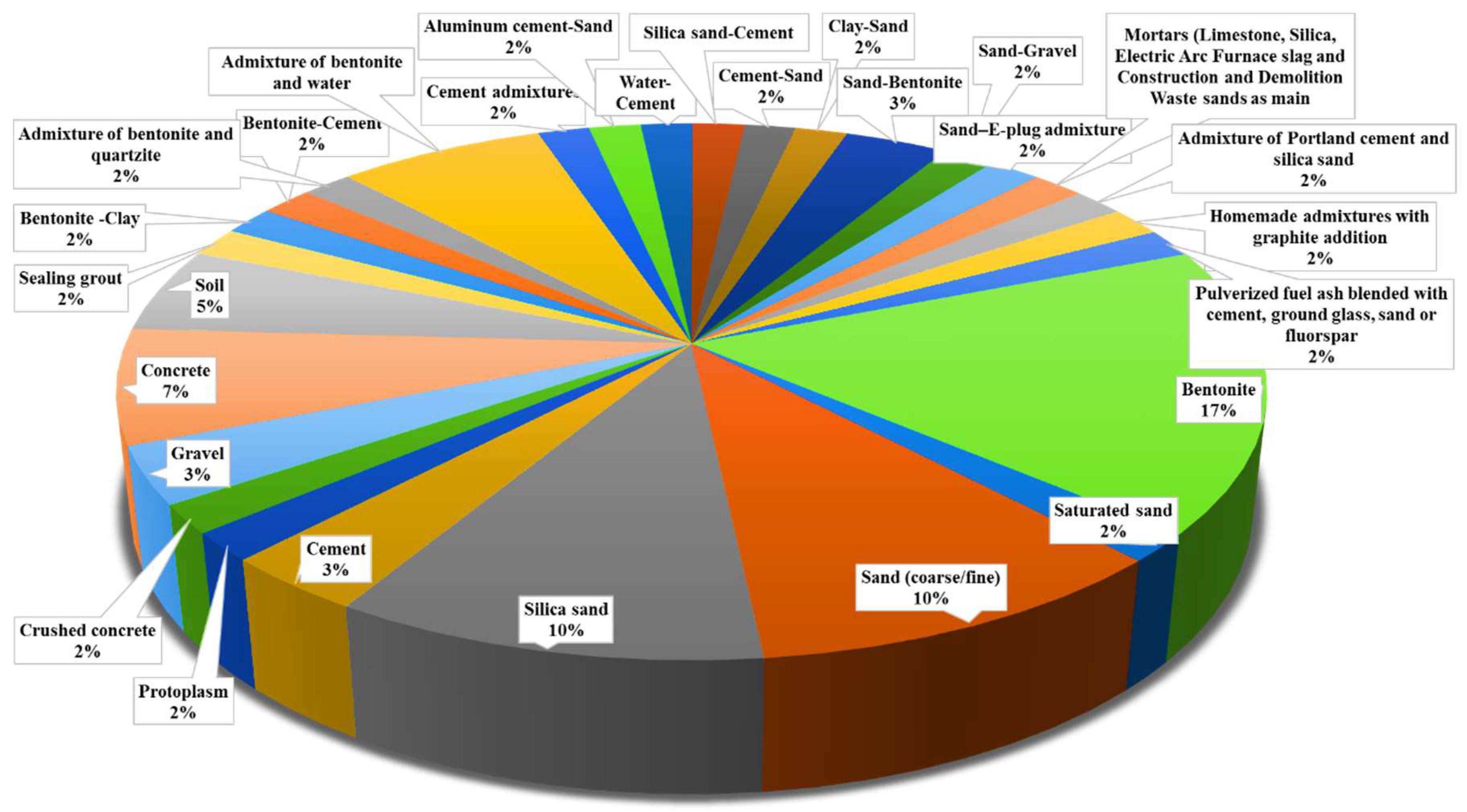
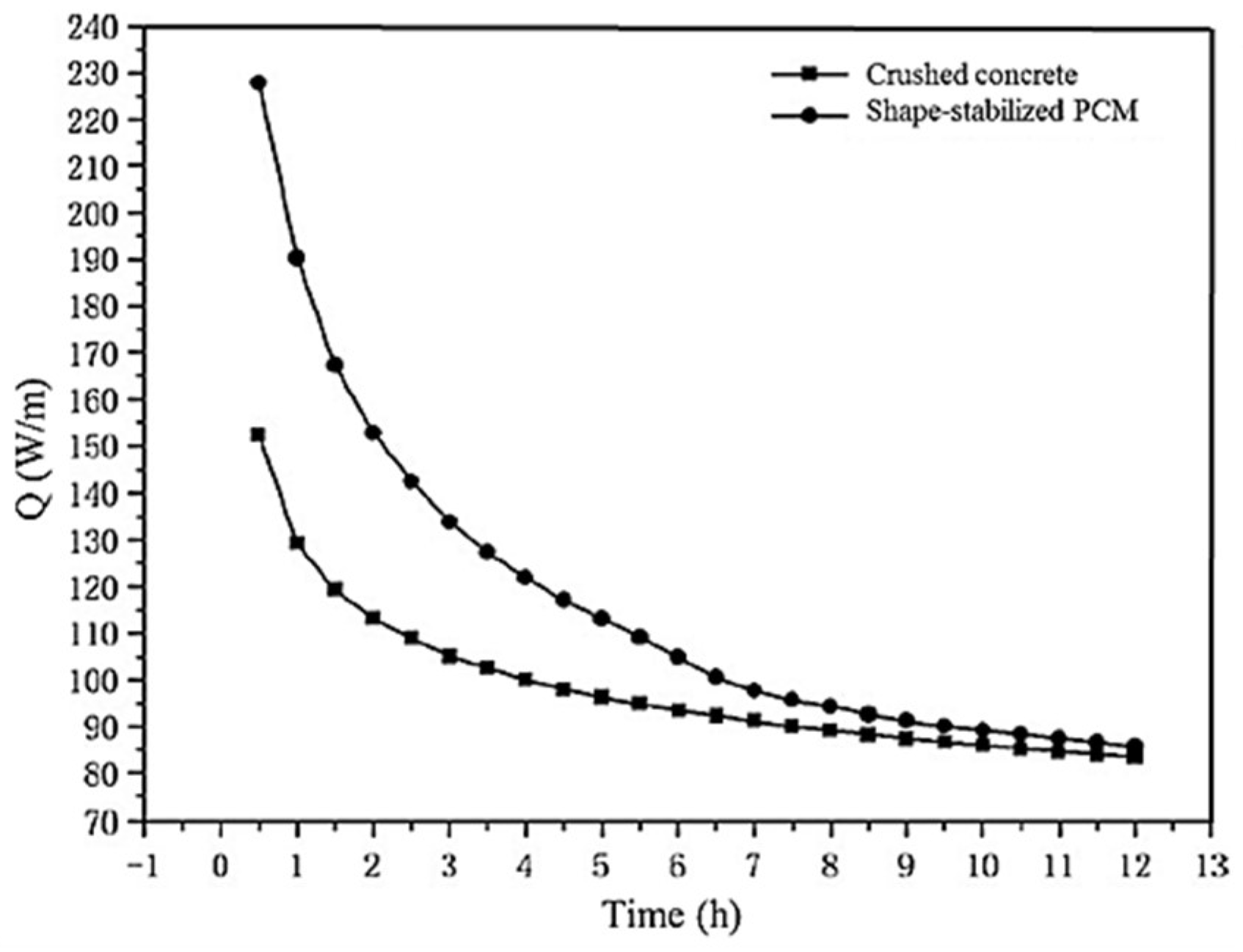
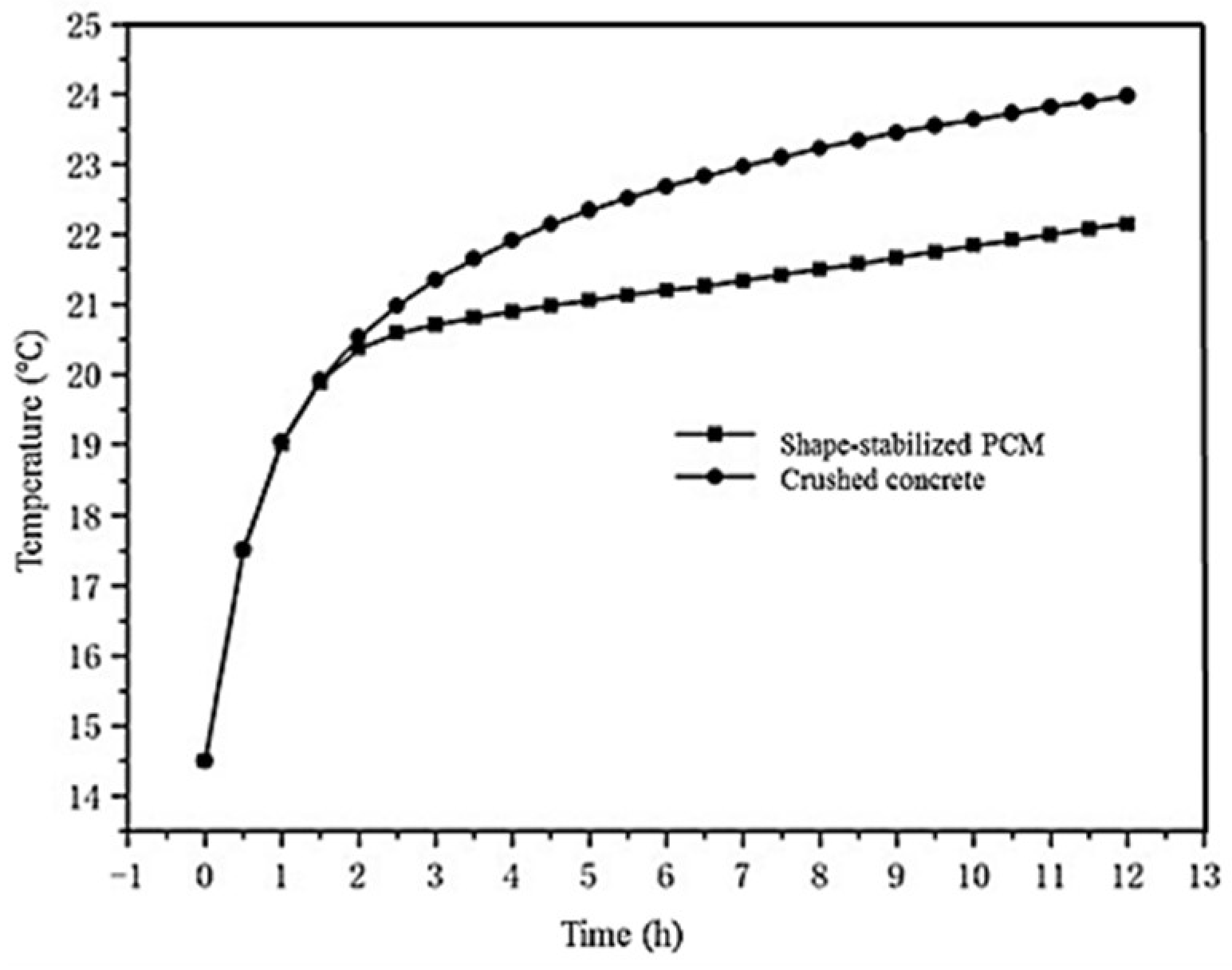
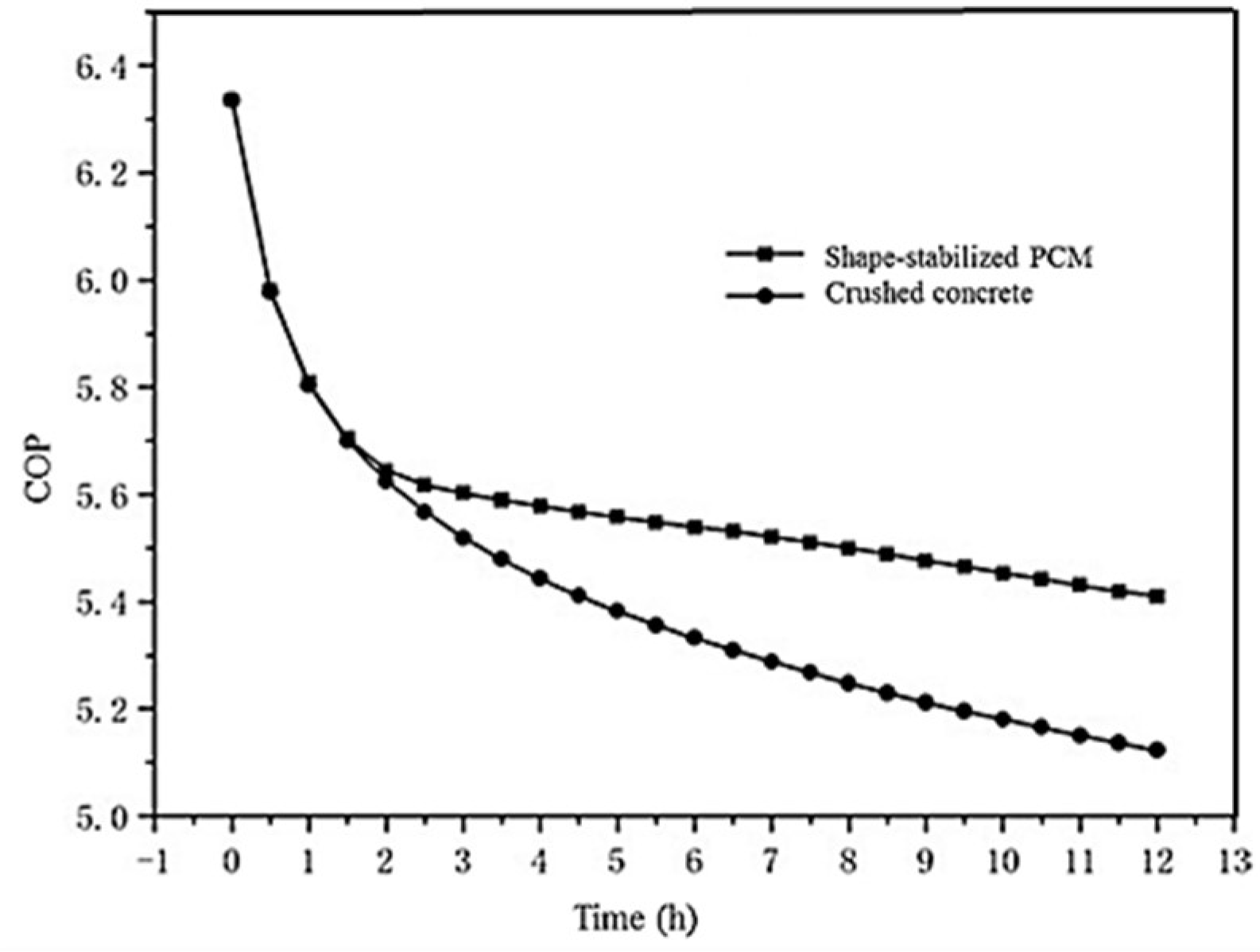
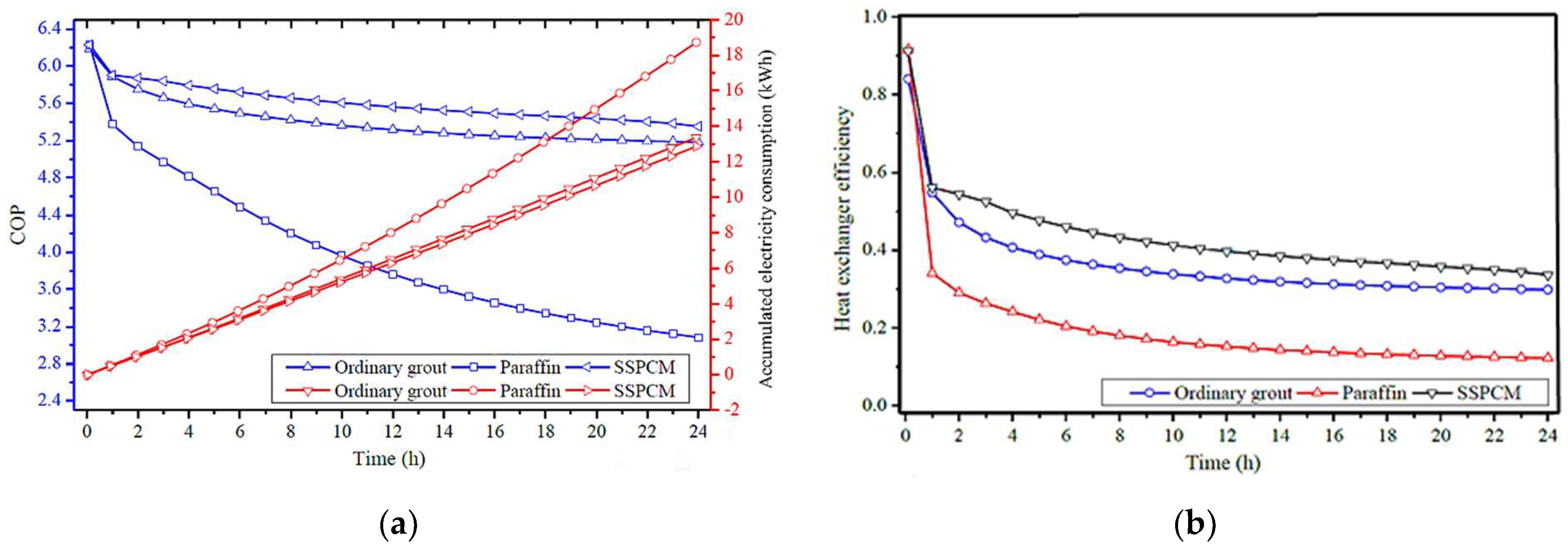

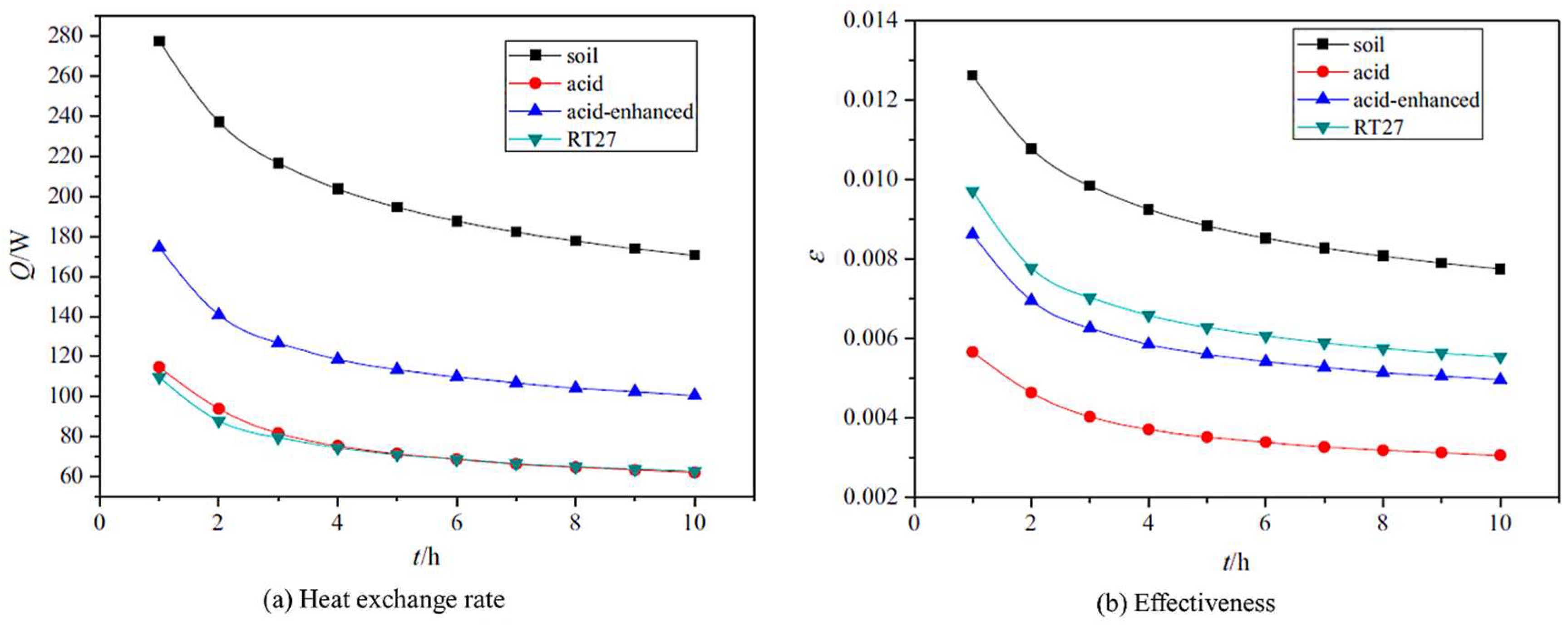

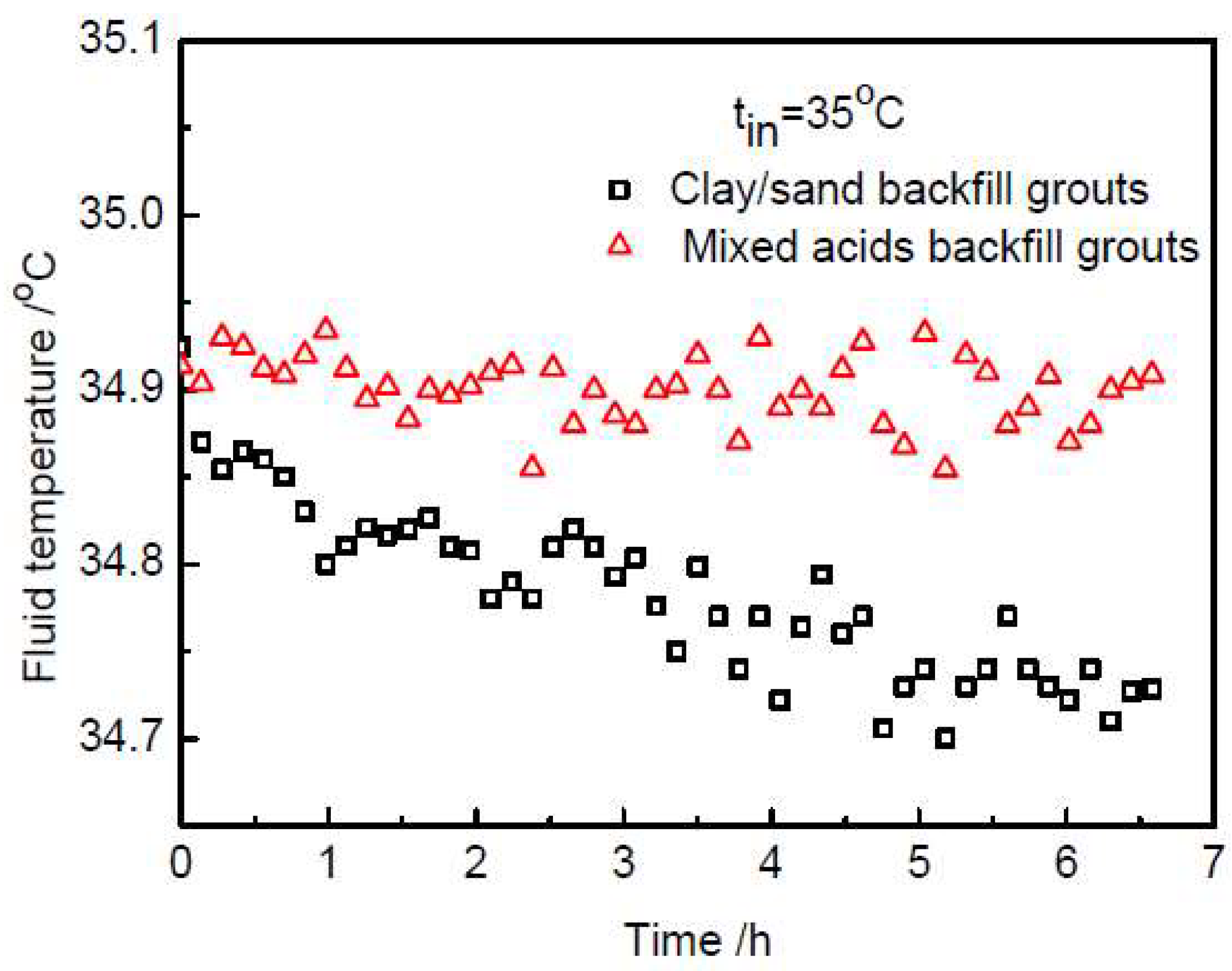
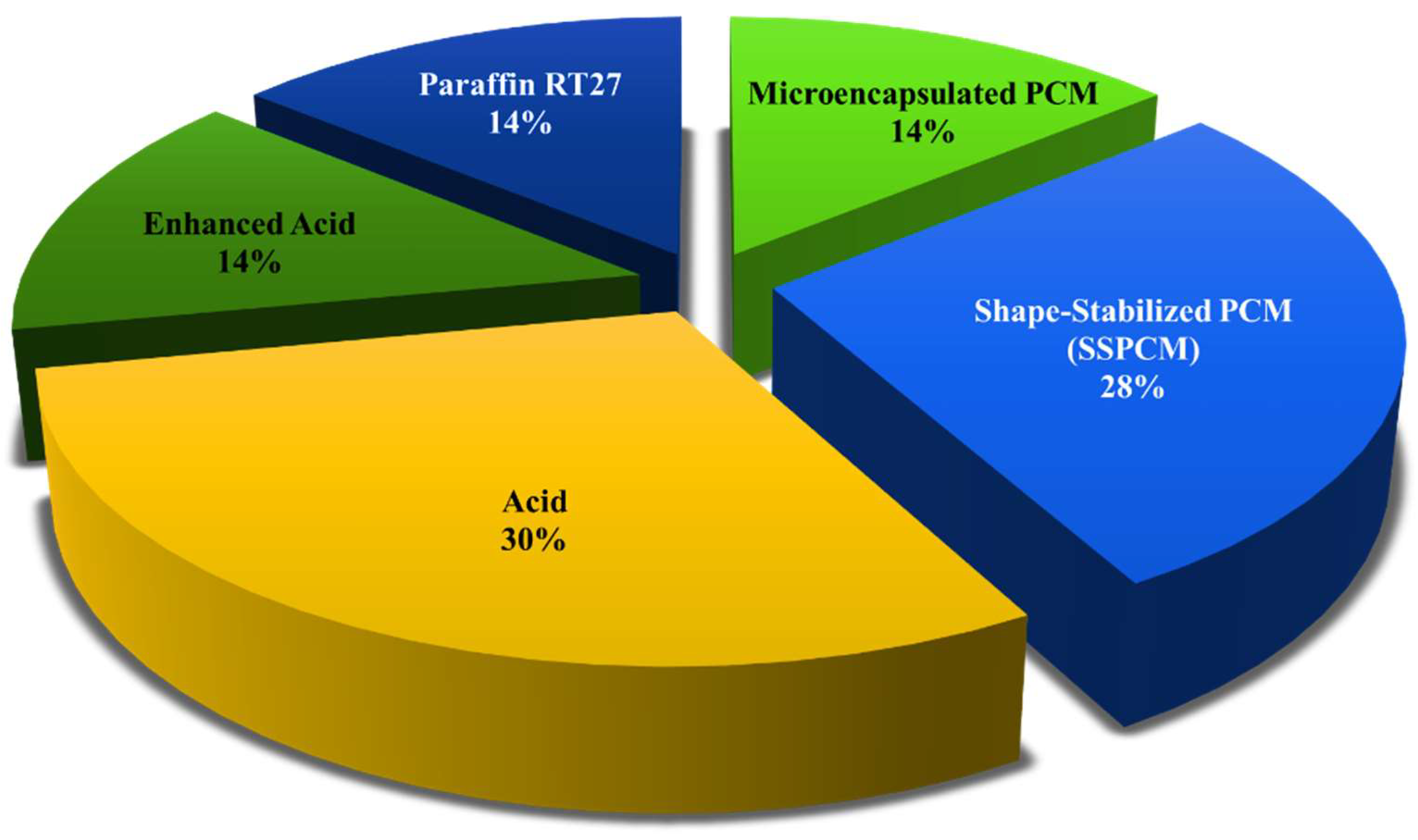

| Operation Mode | Conventional Backfill Material (Pure Material) | ||||||||
|---|---|---|---|---|---|---|---|---|---|
| Bentonite | Saturated Sand | Sand (Coarse/Fine) | Silica Sand | Protoplasm | Gravel | Soil | Quartz Sand | Clay | |
| Heating | √ | √ | √ | √ | √ | √ | √ | √ | √ |
| Cooling | √ | √ | √ | √ | √ | √ | √ | ||
| Operation mode | Conventional Backfill Material (Mixed Material) | |||||||||
| Bentonite-clay | Bentonite-cement | Admixture of bentonite and quartzite | Admixture of bentonite and water | Cement | Cement admixtures | Aluminum cement-sand | Water-cement | Silica sand-cement | Cement-sand | |
| Heating | √ | √ | √ | √ | √ | √ | ||||
| Cooling | √ | √ | √ | √ | √ | √ | √ | √ | √ | |
| Operation mode | Conventional Backfill Material (Mixed Material) | |||||||||
| Clay-sand | Concrete | Crushed concrete | Sand-bentonite | Sand-gravel | Sand–E-plug admixture | Mortars (limestone, silica, electric arc furnace slag and construction and demolition waste sands as main aggregates) | Admixture of Portland cement and silica sand | Homemade admixtures with graphite addition | Pulverized fuel ash blended with cement, ground glass, sand or fluorspar | |
| Heating | √ | √ | √ | √ | √ | √ | ||||
| Cooling | √ | √ | √ | √ | √ | √ | ||||
| Operation Mode | Microencapsulated PCM | Shape-Stabilized PCM (SSPCM) | Acid | Enhanced Acid | Paraffin RT27 |
|---|---|---|---|---|---|
| Cooling | √ | √ | √ | √ | √ |
© 2018 by the authors. Licensee MDPI, Basel, Switzerland. This article is an open access article distributed under the terms and conditions of the Creative Commons Attribution (CC BY) license (http://creativecommons.org/licenses/by/4.0/).
Share and Cite
Javadi, H.; Mousavi Ajarostaghi, S.S.; Rosen, M.A.; Pourfallah, M. A Comprehensive Review of Backfill Materials and Their Effects on Ground Heat Exchanger Performance. Sustainability 2018, 10, 4486. https://doi.org/10.3390/su10124486
Javadi H, Mousavi Ajarostaghi SS, Rosen MA, Pourfallah M. A Comprehensive Review of Backfill Materials and Their Effects on Ground Heat Exchanger Performance. Sustainability. 2018; 10(12):4486. https://doi.org/10.3390/su10124486
Chicago/Turabian StyleJavadi, Hossein, Seyed Soheil Mousavi Ajarostaghi, Marc A. Rosen, and Mohsen Pourfallah. 2018. "A Comprehensive Review of Backfill Materials and Their Effects on Ground Heat Exchanger Performance" Sustainability 10, no. 12: 4486. https://doi.org/10.3390/su10124486
APA StyleJavadi, H., Mousavi Ajarostaghi, S. S., Rosen, M. A., & Pourfallah, M. (2018). A Comprehensive Review of Backfill Materials and Their Effects on Ground Heat Exchanger Performance. Sustainability, 10(12), 4486. https://doi.org/10.3390/su10124486








